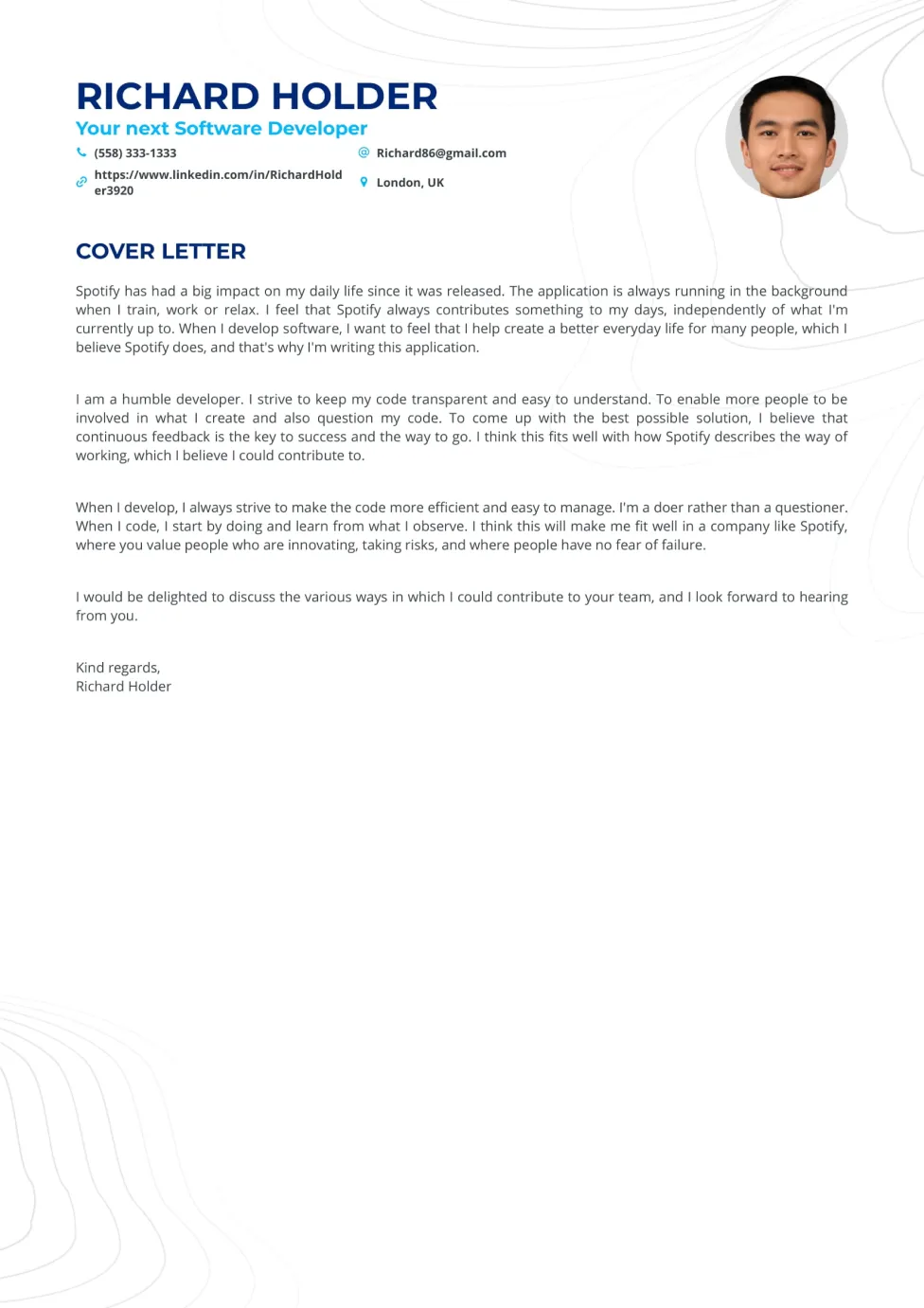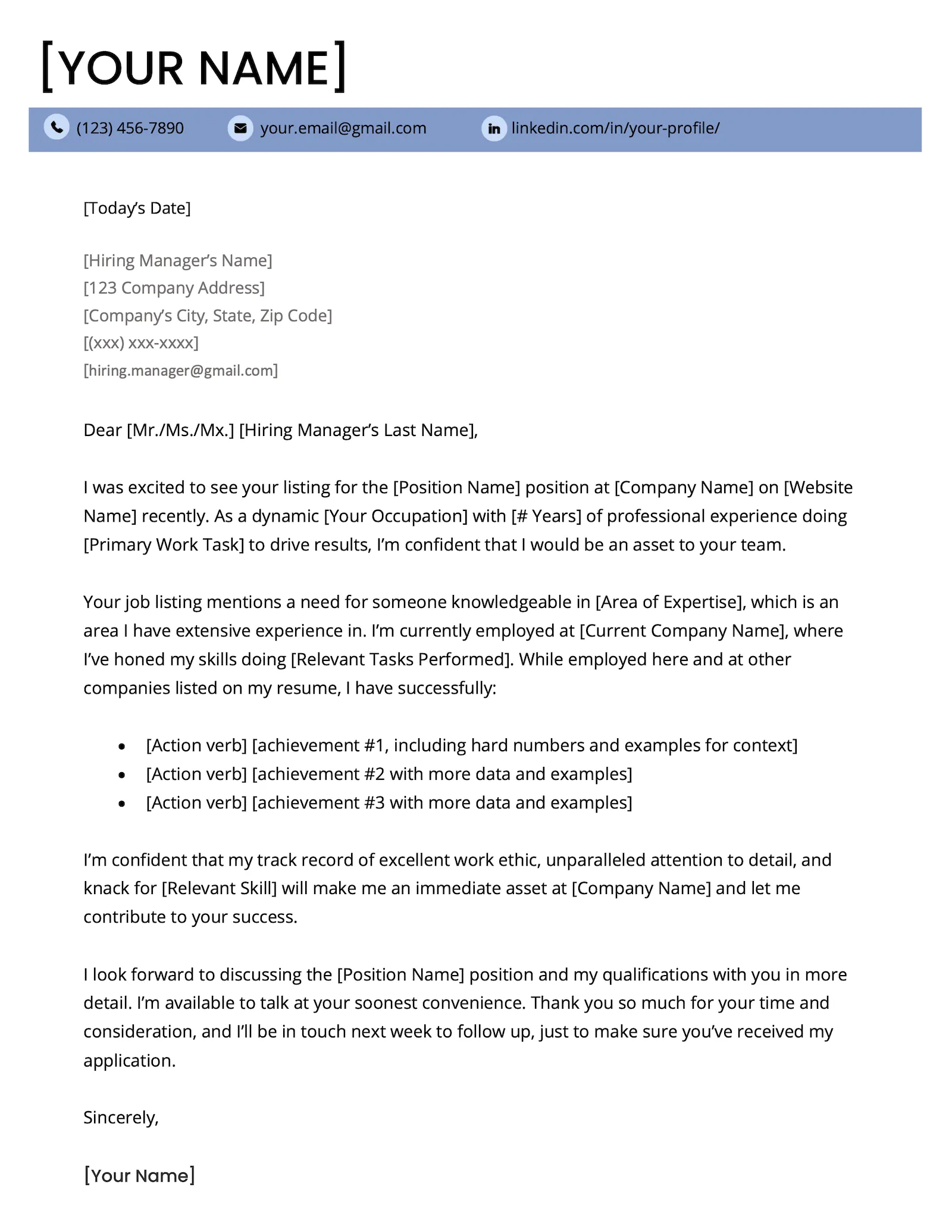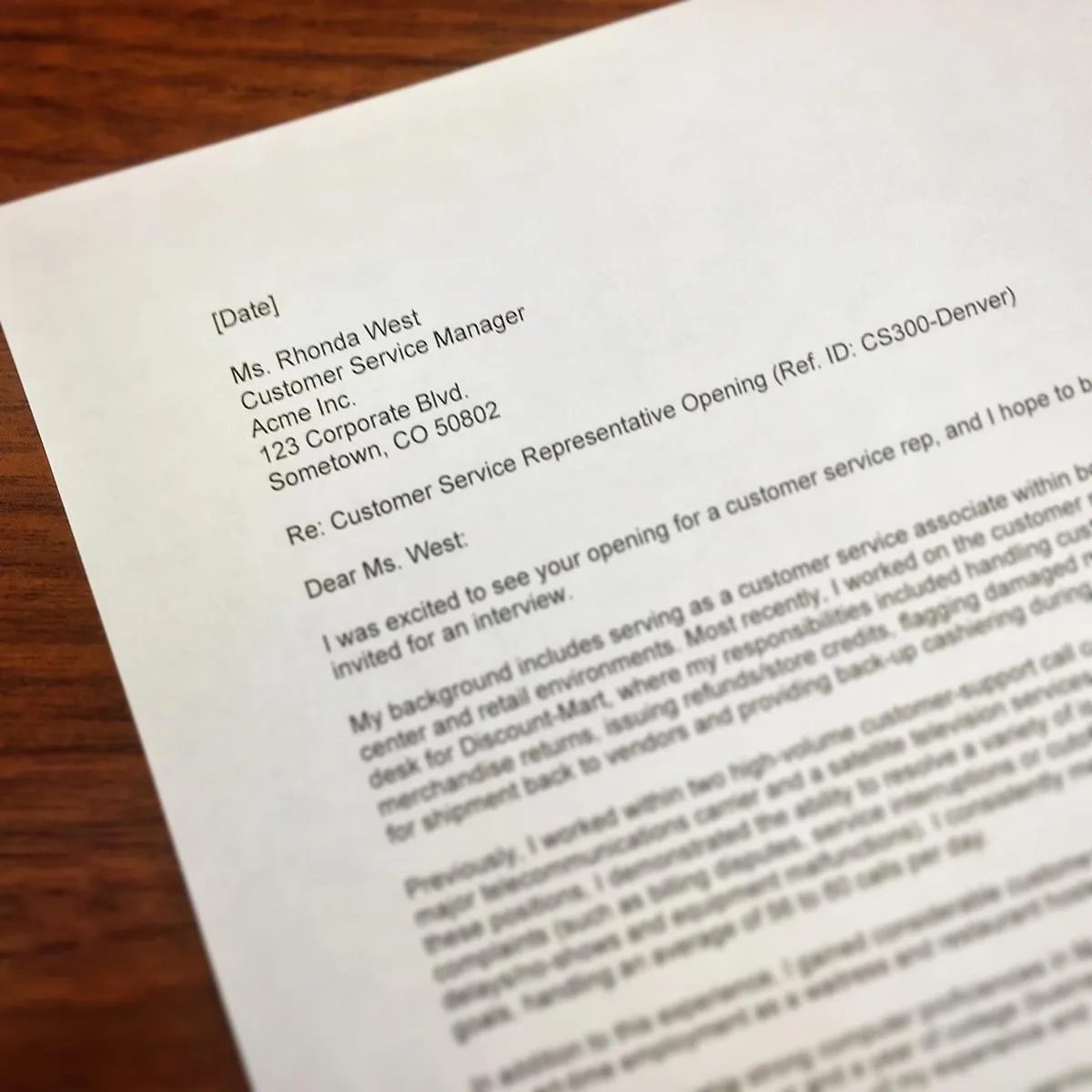What is a Cover Letter and Why Do You Need One
A cover letter is a crucial document that accompanies your resume when applying for a job. It serves as your introduction to the hiring manager, providing context and highlighting your qualifications and interest in the position. Unlike your resume, which lists your experiences and skills, a cover letter allows you to showcase your personality, explain why you’re a good fit for the company, and demonstrate your enthusiasm for the role. Many job seekers often underestimate the power of a well-crafted cover letter, but it can be the deciding factor in whether you get an interview.
The Purpose of a Cover Letter
The primary purpose of a cover letter is to convince the hiring manager that you are the ideal candidate for the job. It’s your chance to make a strong first impression and differentiate yourself from other applicants. The cover letter allows you to provide a narrative, connecting your skills and experiences to the specific requirements of the job. You can explain gaps in your employment history, express your passion for the company’s mission, and demonstrate your understanding of the role. The best cover letters go beyond simply repeating your resume; they provide a compelling argument for why you should be interviewed.
Key Components of an Effective Cover Letter

A strong cover letter includes several key components. It begins with a professional header that includes your contact information and the date. It should be addressed to the hiring manager by name, if possible, to show that you’ve done your research. The body of the letter should open with a compelling introduction that grabs the reader’s attention. The main paragraphs should highlight your most relevant skills and experiences, demonstrating how they align with the job requirements. Finally, the letter should conclude with a strong call to action, expressing your eagerness for an interview and thanking the reader for their time and consideration.
Formatting Your Cover Letter
Formatting your cover letter correctly is essential for making a positive impression. A well-formatted letter is easy to read and visually appealing, which helps the hiring manager focus on your message. Proper formatting includes choosing a clear font, setting appropriate margins and spacing, and using a consistent structure throughout the document. These formatting elements work together to enhance the overall readability and professionalism of your cover letter, showcasing your attention to detail and organizational skills.
Choosing the Right Font and Size
The font and size you choose for your cover letter significantly impact its readability. Opt for a professional, easy-to-read font such as Times New Roman, Arial, Calibri, or Helvetica. These fonts are widely accepted and are easy on the eyes. The font size should typically be between 10 and 12 points. This ensures that your text is large enough to read comfortably without appearing overly large or crowded. Consistency in font choice and size is crucial for a clean and professional look.
Setting Up Your Margins and Spacing

Proper margins and spacing contribute to the overall visual appeal and readability of your cover letter. Set your margins to 1 inch on all sides (top, bottom, left, and right). This creates enough white space around your text, making it easier for the reader to focus on the content. Use single spacing within paragraphs and double spacing between paragraphs. This spacing helps separate your ideas clearly and makes the document appear organized and professional. Consistent margins and spacing demonstrate your attention to detail.
Cover Letter Structure How to Organize it
The structure of your cover letter is critical for delivering your message effectively. A well-structured letter guides the reader through your qualifications and makes a strong case for why you’re the best fit for the job. The structure should include a clear header, a professional greeting, engaging body paragraphs, and a decisive closing. Each section of your cover letter plays a vital role in presenting you as a strong candidate.
Header Information Contact Details
Your header should include your full name, address, phone number, and email address. Place this information at the top of the page, either left-aligned or centered. Ensure your email address is professional; avoid using nicknames or casual email addresses. The header provides the hiring manager with your contact details, making it easy to reach you if they want to schedule an interview. It also establishes a professional presentation from the outset.
Greeting the Hiring Manager

Start your cover letter with a professional greeting. If you know the hiring manager’s name, address the letter to them directly (e.g., “Dear Mr. Smith”). This shows that you’ve taken the time to research the company and the position. If you are unsure of the hiring manager’s name, use a general greeting such as “Dear Hiring Manager” or “Dear [Company Name] Hiring Team.” Avoid generic greetings like “To Whom It May Concern” as they appear impersonal.
Body Paragraphs Highlighting Your Skills
The body paragraphs are the heart of your cover letter. They’re where you showcase your skills, experiences, and enthusiasm for the job. Use these paragraphs to connect your qualifications to the job requirements, explaining why you are a perfect fit. Avoid simply repeating your resume; instead, provide specific examples of your accomplishments and how you can contribute to the company’s success. Tailor each cover letter to the specific job you’re applying for, highlighting the skills and experiences that are most relevant.
The Opening Paragraph Grab Their Attention
The opening paragraph is your opportunity to grab the hiring manager’s attention. Start by stating the position you’re applying for and where you saw the job posting. Briefly mention something that excites you about the role or the company. In a sentence or two, provide a compelling overview of your most relevant skills and experiences. Your opening should clearly indicate your interest in the position and make the hiring manager want to read on. Consider including a brief accomplishment to demonstrate your value.
Highlighting Your Key Skills and Experiences

In the body paragraphs, delve deeper into your key skills and experiences. Review the job description and identify the essential requirements. Provide specific examples of how you have successfully utilized those skills in previous roles. Use the STAR method (Situation, Task, Action, Result) to structure your examples. Describe the situation you were in, the task you needed to complete, the actions you took, and the positive results you achieved. This method makes your accomplishments more tangible and helps the hiring manager visualize your capabilities. Use action verbs to emphasize your achievements and contributions.
Demonstrating Your Value and Enthusiasm
Your cover letter should demonstrate not only your qualifications but also your enthusiasm for the job and the company. Research the company and mention something specific that resonates with you, such as their mission, values, or recent projects. Explain why you are interested in working for them. Show that you have a genuine interest in the role. This demonstrates your proactive approach and suggests that you are more likely to be dedicated and engaged. Reflect your passion for the field and the potential for growth in the position.
The Closing Paragraph Call to Action
The closing paragraph should include a clear call to action. Express your interest in an interview and reiterate your enthusiasm for the position. Thank the hiring manager for their time and consideration. Provide your contact information again and state that you look forward to hearing from them soon. The closing paragraph summarizes your key points, reinforces your interest, and encourages the hiring manager to take the next step by contacting you.
Proofreading and Editing Your Cover Letter

Proofreading and editing your cover letter is essential for ensuring that it is polished, professional, and error-free. Errors in spelling, grammar, or punctuation can create a negative impression, potentially leading to the rejection of your application. Take the time to carefully review your cover letter, correct any mistakes, and ensure that your message is clear and concise. A well-proofread cover letter demonstrates your attention to detail and professionalism.
Common Mistakes to Avoid
Several common mistakes can undermine the effectiveness of your cover letter. Avoid generic cover letters that are not tailored to the specific job or company. Do not simply restate your resume; instead, provide additional details and insights. Avoid using jargon or overly complex language. Be sure to avoid grammatical errors and typos; always proofread carefully. Do not include irrelevant information. Finally, avoid being too informal; maintain a professional tone throughout the letter. These common mistakes must be avoided to make a positive impression.
Tips for Proofreading
Proofreading your cover letter effectively involves several key steps. First, set it aside for a few hours or, ideally, a day before reviewing it. This allows you to come back with a fresh perspective. Read the cover letter aloud, as this can help you catch errors that you might miss when reading silently. Use spell-check and grammar-check tools, but don’t rely on them completely; always review manually. Ask a friend, family member, or career counselor to proofread your cover letter to get a second opinion. Paying close attention to these details can significantly increase the accuracy and impact of your cover letter.
Tailoring Your Cover Letter to the Job

Tailoring your cover letter to each job you apply for is crucial for demonstrating that you are a good fit for the specific role and company. Generic cover letters are easily recognized and often dismissed. By customizing your cover letter, you show the hiring manager that you have taken the time to understand the job requirements and the company’s values. This also demonstrates your genuine interest in the position and increases your chances of being noticed.
Researching the Company
Before writing your cover letter, research the company thoroughly. Visit their website, read their “About Us” page, and browse their social media profiles. Understand their mission, values, and recent projects. This research will help you tailor your cover letter to reflect your understanding of the company and show how your skills align with their goals. It’s essential to demonstrate your understanding of the company culture and values.
Using Keywords from the Job Description
Carefully review the job description and identify the keywords and phrases used to describe the required skills, experiences, and qualifications. Incorporate these keywords naturally into your cover letter. This demonstrates that you meet the specific requirements of the job and increases the likelihood that your application will pass through any automated screening systems (ATS). However, make sure to use the keywords naturally and avoid keyword stuffing, which can make your cover letter appear unnatural or forced.
Cover Letter Examples and Templates
Cover letter examples and templates can be invaluable resources when writing your own cover letter. They provide a framework for structuring your letter, highlighting key elements, and tailoring your message. Using these examples can help you understand the common practices of effective cover letters, as well as see how to present yourself professionally. However, always customize the template to fit your unique experiences and the specific job you are applying for.
Where to Find Cover Letter Templates
There are numerous resources where you can find cover letter templates. Many websites offer free and premium templates, allowing you to choose one that suits your needs. Job search websites, such as Indeed, LinkedIn, and Glassdoor, often provide templates. Additionally, professional resume writing services may offer templates. When selecting a template, choose one that is professional, modern, and easy to customize. Ensure that the template aligns with your personal brand and the job requirements.
Adaptation of Templates to fit Your Need
While cover letter templates provide a useful starting point, it is important to customize them to fit your individual needs and the specific job. Do not simply fill in the blanks of a template. Modify the content to reflect your unique skills, experiences, and the requirements of the job. Tailor the language, tone, and format to match the company’s culture and the specific expectations outlined in the job description. By adapting the template, you demonstrate your ability to tailor your approach to the job.
